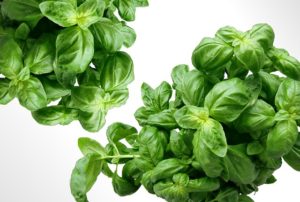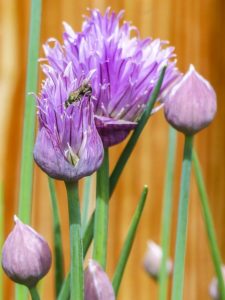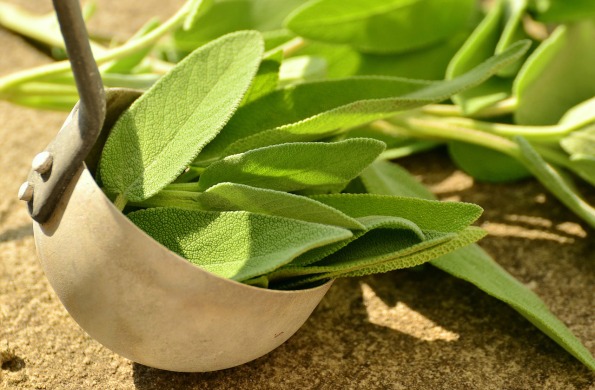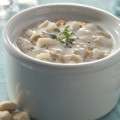I have always been fascinated by the old fashion kitchen gardens that I would read about in some of the books from my youth. A quaint little garden close to the house where you could step out while preparing a meal and simply snip off a leaf or two of whatever herb you needed for the foods you were preparing.
These gardens were usually a combination of herbs and flowers. Some of the flowers were planted simply for their beauty while other would have been used to help keep pests and plant loving animals away.
These gardens were the perfect combination of picturesque and useful, and filled my soul with delight. But whether you have the space directly behind your home for this type of garden or not you can grow your own herbs if you choose, and once you have tried fresh herbs in your food preparation you will never want to go back to the dried store bought varieties ever again.

Basil
Fresh Herbs add color and flavor to whatever you are preparing, and are relatively easy to grow. If you don’t have the space outdoors, or if you simply want to have fresh herbs all year round, you can grow them in pots on a sunny windowsill.
Fresh herbs that can be found in home gardens will depend on the climate as well as the tastes of the gardener/cook who is growing them, but here are a few of the more common varieties that I find most people like to have.
Parsley, Sage, Basil, Mint, Lemon Grass, Coriander, Chives, Thyme, Oregano, Dill, Stevia, Rosemary, and Tarragon
Parsley is one of the best known herbs and may be used in virtually any recipe. Fresh parsley is especially good in eggs, mashed potatoes, soups, pasta, and vegetable dishes as well as in sauces that may be used on various meats. It also looks well as a garnish.
Sage enhances the flavor of seafood, vegetables, stuffing, and savory breads. You can also rub sage with cracked pepper and garlic onto pork before cooking for a delicious new approach.
Basil is another one of the more popular culinary herbs and it is used in a great many Mediterranean dishes, being particularly well suited to tomato based foods. Because it is a pungent herb it pairs up well with garlic and is the main ingredient in pesto. Dried Basil should be added at the beginning of the cooking process, but if you are using it fresh do not add it until the end.
Mint, which came over to the New World with the colonists, is available in several varieties and can be used for an herbal tea that can settle an upset stomach. It is popular on lamb as well vegetables and chocolate desserts, and it’s also attractive as a garnish on custards and fruit dishes. When we were kids we would pick mints leaves and chew them instead of gum. It was a great alternative.
Lemon Grass is predominantly used as an herb in Asian and Caribbean cooking. It has a subtle citrus flavor and may be used in soups, and other simmered dishes as well as in salads. It has many health benefits as it is imbued with antimicrobial and antibacterial properties. It has a pleasant aroma and historically was gathered by women to put into baskets to scent the rooms of their homes.
Coriander, also known as Cilantro can be used in a variety of ways. The fresh leaves of the plant are frequently used in salsas, and seasoned rice dishes, while the seeds of this plant when ground can be used to season dishes in completely different ways. The Coriander spice is often used in curries, pickles, stews, soups and a dish called ratatouille.

Chives
Chives are part of the onion family and an attractive addition to any kitchen garden with its spikey greenery and purple puff ball flowers. They have a taste that is a cross between an onion and garlic and go well chopped and sprinkled on soups, salads, potatoes and eggs.
Thyme is often thought of in French cuisine and is used in soups and sauces that are frequently paired with meat, poultry, and fish. It is also used in seasoning blends for stuffing, and is often paired with tomatoes.
Oregano is a member of the mint family and has been used to flavor dishes since ancient times. It is best known for its connection with Italian cooking, but is also used in many Spanish and Greek dishes as well. Oil of Oregano is also known for its cleansing and immune boosting properties.
Dill is another herb that is beautiful as well as functional. Long slim stems and feathery leaves topped with a star burst of yellow flowers resembles a fireworks display amongst the other greenery. Dill seeds are harvested from these flowers and will keep indefinitely to be used at any time. Whole seeds may be added to potato salads, cabbage dishes, pickles and soups, while the ground seed can be used to flavor breads, butters, and other condiments.
Stevia is a mountain plant from Brazil and Paraguay, and may not be practical for every gardener to have in their own yard, but it is worth knowing about. Extracts made from the leaves of the Stevia plant are so sweet they can be used to replace sugar, and there are no calories. Now that’s sweet!
Rosemary is a small evergreen from the mint family. Covered in lovely small purple/blue flowers it would be an ornament in any garden. Rosemary is an aromatic plant that blends well with garlic and thyme. It is most often used to season meats, stews, and marinades.
Tarragon is used extensively in French dishes and has a subtle licorice like flavor. Tarragon blended together with parsley, chervil, and chives are a traditional blend of herbs used in France. Tarragon is also used in salad dressings and to infuse oils.
It is Hippocrates who is quoted as saying “Let food be thy medicine and medicine be thy food.”

To read more of Denise’s articles, click here.
Food is meant to be enjoyed, as well as to nourish our bodies. It is amazing the uplift of the spirits that can be had from a healthy flavorful meal, especially when it is enjoyed in the company of people we like to be with.
So try something new, experiment a little with different herbs and flavors to see what your family and friends enjoy. We must eat, so try to eat well with healthy flavorful foods, and savor the meals that you create.
Bon Appetit!
Resources
http://www.culinaryherbguide.com/typesofherbs.html
http://whatscookingamerica.net/cilantro.htm
About Denise Mastrocola
Denise is a Michigander turned Pennsylvanian, who has been writing stories since Elementary School. Denise won an award at the annual Lansing Youth Talent Show, when she was in 10th grade, for a short story entitled Procrastination is Fatal, but didn’t decide on writing as a career until she was 28 years old. While homeschooling her older children she spent 4 years working through a course from The Institute of Children’s Literature.
Through the years Denise’s children have had a variety of health issues, many of which have been linked to various sensitives; having spent more than 20 years researching and trying different things Denise has a boots on the ground view on healthier living.
Denise currently writes for 2 blogs and has several books in different stages of completion. She is planning to break ground in e publishing, and hopes to have her first Historical Fantasy book which is set during the renaissance, “Lisa, My Lisa?” ready by the first of the year.
Twitter •






